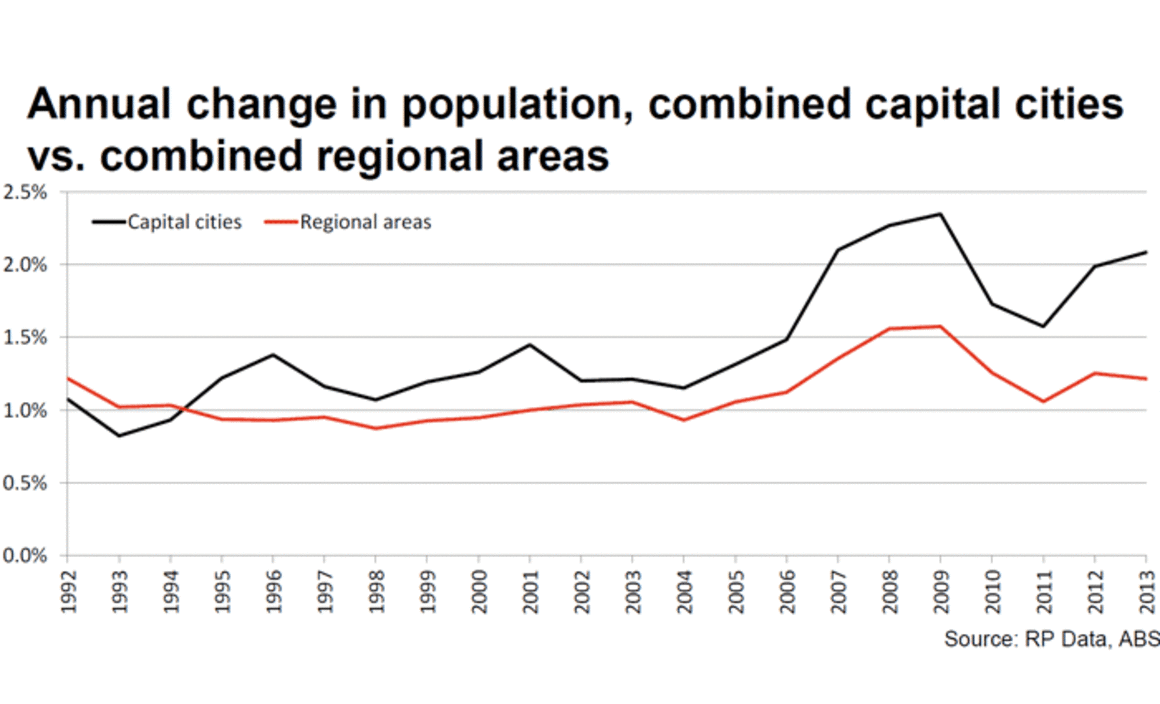Capital cities' job security remains attraction for population growth

Recently released data from the Australian Bureau of Statistics (ABS) shows that as at June 2013, the rate of population growth in Australia’s capital cities was significantly greater than that of regional markets.
Perth topped the charts as the city to consistently record the fastest rate of population growth with 395,000 new persons moving to Perth between 2006 and 2013. However in raw number terms, the increase in population has been much greater in Melbourne and in Sydney.
Between 1991 and 2013 Sydney added an additional 1,084,169 residents, Melbourne 1,153,248, Brisbane 826,621, Adelaide 198,141 and Perth 746,243.
As at June 2013, ABS reported that almost two out of every five Australian’s (39.4%) lived in either Sydney or Melbourne, however, the proportion of Australian’s living in Sydney or Melbourne fell slightly from 1991 (39.7%). This is largely due to a rising prominence of Brisbane and Perth as population centres.
In 1991, 21.3% of Australian’s lived in Sydney, 18.5% in Melbourne, 8.2% in Brisbane and 7.1% in Perth. By 2013, 20.6% of Australian’s lived in Sydney, 18.8% in Melbourne, 9.7% in Brisbane and 8.5% in Perth. Despite the declining prominence of Sydney, the proportion of Australian’s living within our four largest cities has increased from 55.0% in 1991 to 57.6% currently.

The rising prominence of Brisbane and Perth as population centres has really emerged over recent years. Obviously the resources sector boom has driven this to some extent with escalating demand for professionals working and associated with this sector.
Darwin was the only other capital city to record an increase in its overall proportion of the national population over the period, shifting from 0.5% in 1991 to 0.6% in 2013.
Adelaide recorded the largest decline in its proportion of population over the period across the capital cities, falling from 6.3% of the national population in 1991 to 5.6% in 2013.
Sydney and Melbourne continued to be the most significant population centres however; Melbourne is catching Sydney quite quickly. In 1991, 3,672,914 persons lived in Sydney and 3,194,707 in Melbourne, a gap of 478,207 persons. By 2013, the gap had reduced to 409,128 persons.
During the same period, regional Queensland was the only regional market to record a greater increase in population than within the capital city. Over the period, Brisbane's population increased by a total of 826,621 persons compared to an 869,231 increase in Regional Queensland’s population.
The surge in population across Regional Queensland is linked to the growth in those markets directly adjacent to Brisbane, Gold Coast and Sunshine Coast.
Regional Queensland’s population has increased due to the ‘sea change’ phenomenon which has seen significant migration and development along the state’s coastal communities.
Over the year, the ABS reported that Australia's population increased by 1.8% with capital city regions recording population growth of 2.1% over the year compared to a 1.2% annual increase in regional population.

From 1995 onwards, capital city populations have consistently increased at a faster rate than those in regional areas. In June 1991, 64.6% of all Australian’s lived within a capital city and by June 2013 the proportion had risen to 66%.
Almost two thirds (66.3%) of all Australian’s live within a capital city, up from 64.6% in 1991.
Based on the ABS results, Australian’s are showing an ongoing preference to live in capital cities rather than regional markets. This is largely due to job security found in the cities.
With home values rising at a much faster rate in Sydney and in Melbourne than in other capital cities it will be interesting to see over the coming years if we see an outflow of population from Sydney and Melbourne to other more affordable capital city housing markets such as Brisbane and Adelaide.
Of course a key driver of any shift away from Sydney and Melbourne will be providing well-paid jobs and a high quality of life while ensuring that housing remains relatively more affordable than it is within Sydney and Melbourne.